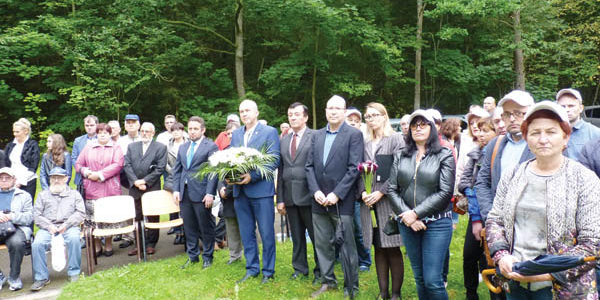
by Loreta Ežerskytė, Gimtoji žemė, the newspaper of the Ukmergė region
For more than 60 years now the mass murder of 12,000 Jews has been marked on the first Sunday in September in the Pivonija forest near Ukmergė [Vilkomir]. The commemoration happens at noon at the mass grave. Those who cannot attend, whose family members or other loved ones are buried here, mark the tragedy by lighting candles and praying at home. On Sunday many candles burned in Israel, the United States, South Africa and other countries whither fate sent Jews from Ukmergė.
The commemoration of the third-largest Holocaust mass murder site in Lithuania was attended by members of the Ukmergė Jewish Community and a large contingent of Jews from the Panevėžys, Šiauliai, Vilnius and Kaunas Jewish Communities as well as from other cities and countries. Regional administration head Rolandas Janickas and municipal administration director Stasys Jackūnas attended, and US embassy Vilnius deputy chief of mission Howard Solomon attended for the second year in a row.
A group from the Dukstyna primary school and local residents also attended the commemoration. Ukmergė Jewish Community chairman Artūras Taicas told those in attendance about how Jews were brought in groups there 76 years ago: “They were brought by the Nazis and local collaborators. No one had any mercy for the women or children, never mind the men. They all suffered the same fate. They were murdered because they were Jews. Only a few individuals survived, those who were deported. In the Taicas family only my grandfather survived, and that’s why I am standing here…”
Taicas thanked those who turned out and reminded them “this is not just a Jewish tragedy, but everyone’s tragedy.”
This is the fourteenth time Dukstyna primary school history teacher Vida Pulkauninkienė has taken her students to the Pivonija forest. She said it’s their first history lesson of the school year. The Dukstyna residents usually present an artistic composition.
Regional administration head Rolandas Janickas said the tragedy of Pivonija forest happened because of a lack of concern for our neighbors, our brother, sister, friend and neighbor. He said to make sure it never happens again, we must know the past and learn from past mistakes. “I wish for you to create a Lithuania where there is less apathy,” he said.
US embassy representative Howard Solomon address the audience in Lithuanian, thanking organizers for the opportunity to be there and learn firsthand of the tragic events. He said the presence of the teacher and students, Jewish community leaders and government officials was inspiring and lent hope that the tragedy would not be repeated.
In celebration of the European Day of Jewish Culture, the regional history museum featured an exhibit by Gregory Fridberg called “Lithuania Is My First Love, but Israel Is My Life” and part of the comic illustrations by Litvak Al Jaffee in the book “Al Jaffee’s Mad Life: A Biography.”
All events were organized by the Ukmergė Jewish Community with the financial support of the Goodwill Foundation.
An event was held Monday in Želva, an old Jewish shtetl. The town unveiled a new information stand including a map of Želva from the period between the two world wars. The project was financed by the Lithuanian Cultural Heritage Department under the Lithuanian Ministry of Culture and was carried out with the aid of Želva teacher and history researcher, Želva Gymnasium Museum director Zita Kriaučiūnienė. She also organized a walking tour of Želva. Vilna Gaon State Jewish Museum educator Jurga Jackevičiūtė also presented educational material for teaching about the Sabbath.
Full story in Lithuanian with photographs here.

